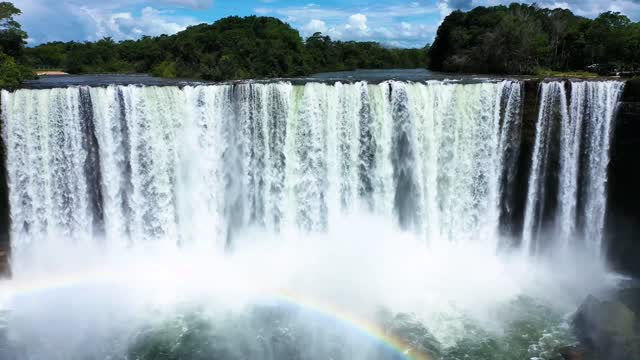Premium Only Content

The Most Beautiful Waterfalls in the World
What are waterfalls of nature? Well in this video you can see how beautiful this waterfall is. The sound of the water crashing down against the rocks below. The wistful winds and the sparkling summer sun that shines through the water. It's so comforting to look at.
The waterfall is stunningly beautiful like aquatic blue as it flows gracefully downstream. A waterfall is a river or other body of water's steep fall over a rocky ledge into a plunge pool below. Waterfalls are also called cascades.
The process of erosion, the wearing away of earth, plays an important part in the formation of waterfalls. Waterfalls themselves also contribute to erosion.
Often, waterfalls form as streams flow from soft rock to hard rock. This happens both laterally (as a stream flows across the earth) and vertically (as the stream drops in a waterfall). In both cases, the soft rock erodes, leaving a hard ledge over which the stream falls.
A fall line is the imaginary line along which parallel rivers plunge as they flow from uplands to lowlands. Many waterfalls in an area help geologists and hydrologists determine a region's fall line and underlying rock structure.
As a stream flows, it carries sediment. The sediment can be microscopic silt, pebbles, or even boulders. Sediment can erode stream beds made of soft rock, such as sandstone or limestone. Eventually, the stream's channel cuts so deep into the stream bed that only a harder rock, such as granite, remains. Waterfalls develop as these granite formations form cliffs and ledges.
A stream's velocity increases as it nears a waterfall, increasing the amount of erosion taking place. The movement of water at the top of a waterfall can erode rocks to be very flat and smooth. Rushing water and sediment topple over the waterfall, eroding the plunge pool at the base. The crashing flow of the water may also create powerful whirlpools that erode the rock of the plunge pool beneath them.
The resulting erosion at the base of a waterfall can be very dramatic, and cause the waterfall to "recede." The area behind the waterfall is worn away, creating a hollow, cave-like structure called a "rock shelter." Eventually, the rocky ledge (called the outcropping) may tumble down, sending boulders into the stream bed and plunge pool below. This causes the waterfall to "recede" many meters upstream. The waterfall erosion process starts again, breaking down the boulders of the former outcropping.
Erosion is just one process that can form waterfalls. A waterfall may form across a fault, or crack in the Earth’s surface. An earthquake, landslide, glacier, or volcano may also disrupt stream beds and help create waterfalls.
If you like my premium videos, please comment down below and have yourself a wonderful day.
-
 2:34
2:34
Kellkell4 Premium Videos
1 month agoSilly Arse & Water Jug
514 -
 20:29
20:29
T-SPLY
16 hours agoWashington Governor Under Risk Of Being Arrested!
4.22K20 -
 2:08:43
2:08:43
The Quartering
2 hours agoTrump's Big Announcement LIVE & Today's News!
133K26 -
 1:45:59
1:45:59
Tucker Carlson
4 hours agoAaron Lewis on Being Blacklisted from Radio & Why Record Labels Intentionally Promote Terrible Music
36.1K25 -
 5:55
5:55
Coin Stories with Natalie Brunell
5 hours agoWho's Selling Bitcoin? Preston Pysh on Bearish Sentiment, Bitcoin Treasury Warning Signs and Ponzis
14 -
 8:53
8:53
Dr. Nick Zyrowski
3 months agoStarve Fat Cells, ( Not Yourself ) - Ultimate Fat Loss Guide
5.91K1 -
 2:07:34
2:07:34
Tim Pool
4 hours agoWill AI Destroy Humanity? Can Humans Escape AI Doomsday Debate | The Culture War With Tim Pool
91.2K38 -
 35:53
35:53
Lara Logan
11 hours agoACCOUNTABILITY AND A NATION BETRAYED | General Michael Flynn | Episode 32
17.9K14 -
 3:33
3:33
Michael Heaver
7 hours agoEngland Witnesses By-Election BOMBSHELL
19.5K2 -
 1:04:41
1:04:41
Steven Crowder
23 hours agoIslamic Love in America: Crowder Torches PBS's New Muslim Propaganda Documentary
246K171